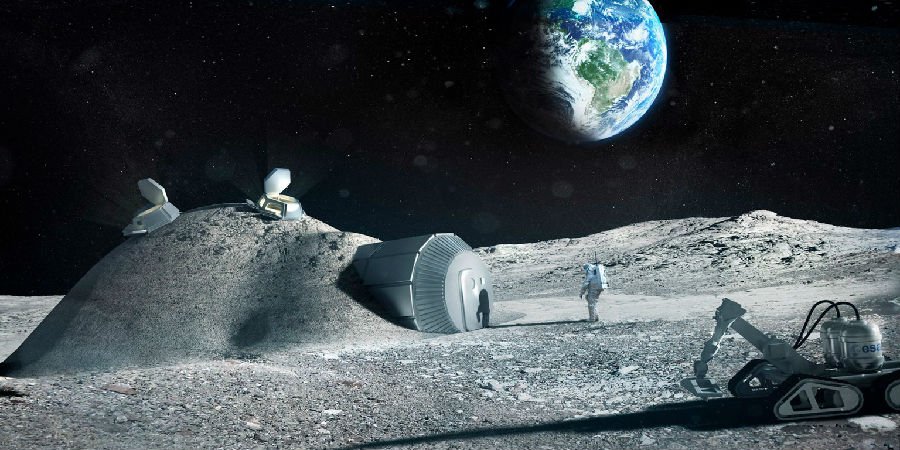(单词翻译:单击)
When it comes to space colonization, Mars is at the forefront of modern exploration.
提到太空殖民,火星可以说是现代太空探索的最前沿了。
Meanwhile, our nearest celestial neighbor - the Moon - is seemingly overlooked.
而距离我们最近的天体 - 月亮 - 却似乎被忽略了。
And that's, in part, because the Moon isn't exactly a haven for humanity.
这,在某种程度上,是因为月亮其实算不上人类的避风港。
The lunar surface is covered with dead volcanoes, massive craters and potentially poisonous dust.
因为月球表面布满了死火山,巨大的陨石坑和潜在的有毒尘埃。
It's also constantly bombarded by space rocks raining down on its surface due to its very thin and weak atmosphere known as an exosphere.
还会因为其外部的大气层(也即“外大气层”)太过稀薄脆弱而不断受到砸落在其表面的太空石的撞击。
On top of that, this ultra thin layer of gases doesn't provide any protection from the sun's radiation.
除此之外,这一超薄的大气层不能提供任何抗太阳辐射的保护作用。
But some scientists believe this wasn't always the case.
但部分科学家认为情况并非总是如此。
Recent NASA findings show that there might have been a time when the Moon had a prominent atmosphere,
美国宇航局最近的调查结果显示,月球可能也有过厚厚的大气层,
and it could make the Moon a stronger contender for colonization.
而且原本可以使月球成为人类太空殖民时的有力的对手。
Billions of years ago, after the formation of the inner solar system,
数十亿年前,太阳系内部形成后,
it's believed, that the young planets and the moon were pummeled by space rocks and other leftover planet-building material.
人们认为,那些年轻的行星和月球反复受到了太空石和其他剩余的行星材料的撞击。
The period known as the Late Heavy Bombardment or LBH is thought to have lasted millions of years,
人们认为,这一“晚期重撞期”,简称LBH时期,已经持续了数百万年,
and damage from this violent period was seen in craters on some of the inner planets and the Moon.
而我们可以从太阳系的某些行星和月球表面的陨石坑看到这一动荡的时期造成的破坏。
There, the LBH triggered a series of volcanic eruptions.
就是这些撞击引发了这些行星上一系列火山的爆发。
Lava filled the lunar craters, creating seas that stretched for hundreds of kilometers across its surface.
熔岩漫入月球表面的陨石坑,在其表面形成了绵延数百公里的海洋。
During this period, it's thought that the lunar lava emitted gas components or volatiles like carbon monoxide, sulfur, hydrogen and oxygen.
人们认为,在此期间,月球表面的熔岩会释放出一氧化碳,硫,氢和氧等气体成分或挥发物质。
As the lava spread, the volatiles accumulated and formed a transient atmosphere.
而随着岩浆的扩散,挥发物积聚并形成短暂的大气层。
The ancient atmosphere was believed to be much thinner than Earth's current atmosphere,
人们认为,尽管月球古代的大气层比地球目前的大气层要稀薄得多,
but 1.5 times thicker than Mars' current atmosphere.
但还是比火星当前的大气层厚1.5倍。
The eruptions lasted for about 70 million years, and it's estimated that trillions of gallons of water was released during this period.
火山爆发持续了将近7000万年,释放的水据估计有数万亿加仑。
As the atmosphere started to thin out,
随着大气层开始变薄,
the volatiles were either lost to space or became part of the surface of the Moon.
挥发物质要么遗失到了太空,要么成为了月球表面的一部分。
Researchers believe it's possible that a significant amount of water may have made its way to the lunar poles and could be trapped in permanently shadowed regions.
研究人员认为,可能已经有大量的水流入了月球极地,而那些水可能会被禁锢在永恒的阴影地带。
In fact, NASA's new analysis quantifies a source of volatiles based on lunar samples collected during the Apollo missions.
事实上,根据阿波罗任务期间收集的月球样本,美国宇航局最近的分析对挥发物的来源进行了量化。
And these volatiles could provide key resources - like water, air and fuel - for extended moon missions and beyond.
而这些挥发物可以在人类延长月球任务及其他任务时为人类提供关键的资源 - 如水,空气和燃料。
So while Mars is still a frontrunner when it comes to colonization,
换句话说,虽然火星在太空殖民探索领域仍然处于领先地位,
revelations about the Moon's past and its potential presence of water continue to prove that there is still a lot more lunar exploration needed before we count the Moon out.
但有关月球的过去以及其存在水源的可能性继续证明着,在我们将月球排除在殖民名单外之前,月球还有很大的值得探索的空间。
If you want to see more Space Crafts check out this playlist here
想查看更多有关宇宙飞船的视频,请点击此处的此播放列表,
And be sure to let us know in the comments what astronomical phenomena you want to learn more about.
请务必在评论中告诉我们您想要了解的天文现象。
Thanks for watching Seeker! Don't forget to subscribe.
感谢您收看《科学探索之旅》!别忘了订阅噢。


